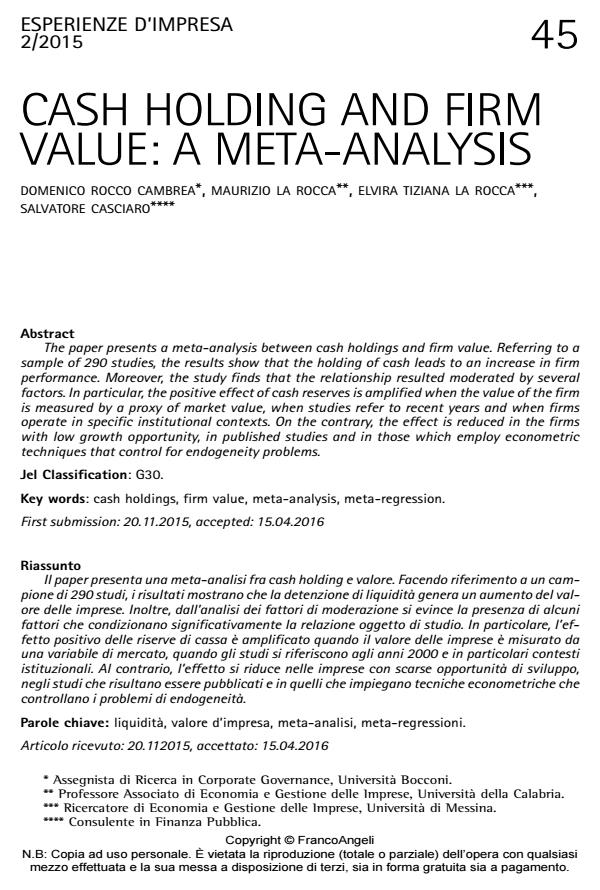Cash holding and firm value: a meta-analysis
Titolo Rivista ESPERIENZE D'IMPRESA
Autori/Curatori Domenico Rocco Cambrea, Maurizio La Rocca, Elvira Tiziana La Rocca, Salvatore Casciaro
Anno di pubblicazione 2017 Fascicolo 2015/2
Lingua Inglese Numero pagine 28 P. 45-72 Dimensione file 227 KB
DOI 10.3280/EI2015-002002
Il DOI è il codice a barre della proprietà intellettuale: per saperne di più
clicca qui
Qui sotto puoi vedere in anteprima la prima pagina di questo articolo.
Se questo articolo ti interessa, lo puoi acquistare (e scaricare in formato pdf) seguendo le facili indicazioni per acquistare il download credit. Acquista Download Credits per scaricare questo Articolo in formato PDF

FrancoAngeli è membro della Publishers International Linking Association, Inc (PILA)associazione indipendente e non profit per facilitare (attraverso i servizi tecnologici implementati da CrossRef.org) l’accesso degli studiosi ai contenuti digitali nelle pubblicazioni professionali e scientifiche
The paper presents a meta-analysis between cash holdings and firm value. Referring to a sample of 290 studies, the results show that the holding of cash leads to an increase in firm performance. Moreover, the study finds that the relationship resulted moderated by several factors. In particular, the positive effect of cash reserves is amplified when the value of the firm is measured by a proxy of market value, when studies refer to recent years and when firms operate in specific institutional contexts. On the contrary, the effect is reduced in the firms with low growth opportunity, in published studies and in those which employ econometric techniques that control for endogeneity problems. .
Il paper presenta una meta-analisi fra cash holding e valore. Facendo riferimento a un campione di 290 studi, i risultati mostrano che la detenzione di liquidità genera un aumento del valore delle imprese. Inoltre, dall’analisi dei fattori di moderazione si evince la presenza di alcuni fattori che condizionano significativamente la relazione oggetto di studio. In particolare, l’effetto positivo delle riserve di cassa è amplificato quando il valore delle imprese è misurato da una variabile di mercato, quando gli studi si riferiscono agli anni 2000 e in particolari contesti istituzionali. Al contrario, l’effetto si riduce nelle imprese con scarse opportunità di sviluppo, negli studi che risultano essere pubblicati e in quelli che impiegano tecniche econometriche che controllano i problemi di endogeneità.
Parole chiave:Liquidità, valore d’impresa, meta-analisi, meta-regressioni.
Jel codes:G30
Domenico Rocco Cambrea, Maurizio La Rocca, Elvira Tiziana La Rocca, Salvatore Casciaro, Cash holding and firm value: a meta-analysis in "ESPERIENZE D'IMPRESA" 2/2015, pp 45-72, DOI: 10.3280/EI2015-002002